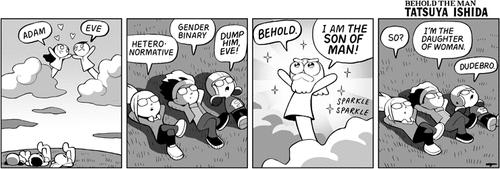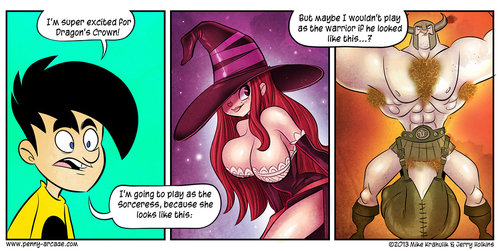[Editor’s Note: This article has been partially revised from its original form at the request of the SFWA to remove material which may have infringed on a copyright.]
ETA: For some links and commentary on this issue, check out this list which Jim Hines compiled.
Considering that I’m not a member of the SFWA (Science Fiction and Fantasy Writers of America), anyone reading this article can take it with so much salt that they go into a self-induced hypertensive shock. But rather than add my name to the list of voices condemning writer-members Mike Resnick and Barry Malzberg for their ill-written rebuttal to critiques of their anti-feminism in the organization’s most recent quarterly newsletter, I’m going to instead talk about how the entire mess could have been avoided in the first place. And to do that, I have to throw Bulletin writer/editor Jean Rabe under a bus.
Problem #1: It all began when issues #199 and #200 of the Bulletin came out in Fall 2012 and Winter 2013 wherein as part of their ongoing dialogues about the industry, Resnick and Malzberg spoke about a certain selection of other writers and editors. Since the Bulletin is a print-only publication that’s only available to SFWA members, I only have E. Catherine Tobler’s recollection of the dialogue to go by, for now:
How fantastic, I thought, because I, being a writer and an editor and female, had a keen interest in [learning about other female writers and editors]. I love reading anthologies such as Women of Wonder (and its sequel) and seeing how women impacted and contributed to this forward-looking and -thinking genre I love. I hoped they might include the women who inspired me and introduce me to many I hadn’t yet discovered.
That’s not what I found. I found a dialogue that seemed more focused on how these “lady editors” and “lady writers” looked in bathing suits, and that they were “beauty pageant beautiful” or a “knock out.” I am certain no condescension was intended with the use of “lady,” but as the dialogues went on, I felt the word carried a certain tone—perhaps that was a fiction of my own making. As I listened to these two men talk about lady editors and writers they had known, I grew uneasy. Something wasn’t right.
ETA: Tobler graciously pointed out to me by email these paraphrased quotes from Malzberg and Resnick on “lady editors” from Issue #200, which were recapped by moderator Alessandra Kelley at the Absolute Write.com forums:
[Barry Malzberg]
Almost synchronous with her [Catherine Tarrant’s] entrance was that of Beatrice Mahaffey as Raymond Palmer’s assistant editor when Palmer left Amazing to originate a series of his own magazines (beginning with Other Worlds) and I will leave it to you to introduce her; you knew her from the SF community of your early years and were, with so many, an admirer. She was competent, unpretentious, and beauty pageant gorgeous … as photographs make quite clear. Tell succeeding generations all about her, please.
Mike
Ah, Bea Mahaffey…
She was the only pro I knew in Cincinnati when we moved here from the Chicago area more than a third of a century ago. She was incredibly generous with her time and reminiscences, and I spent a lot of time with her, on the phone and in person, duting the first few months when I was learning my way around town.
Anyone who’s seen photos of Bea from the 1950s knows she was a knockout as a young woman.
and
[Mike Resnick:] Another story is from nonagenarian Margaret Keiffer, who lives just a couple of miles from us. She’s the widow of super-fan Don Ford, who ran the 1949 Worldcon, and founded both Midwestcon and First Fandom. Don also created CFG (the Cincinnati Fantasy Group), the venerable local club to which Carol and I belong. According to Margaret, during its first few years of existence CFG was populated exclusively by men. Then Bea joined. Then the members’ wives got a look at Bea in her swimsuit at the 1950 Midwestcon. Then the club’s makeup changed to the 50% men and 50% women that has existed ever since.
Where Jean Rabe Went Wrong, #1: Having just learned through incoming president Steven Gould that Rabe was appointed to be editor of the Bulletin by outgoing president John Scalzi then-president Russell Davis when previous issues were months late, I can understand that there’s a chance that Rabe may not have gotten a good chance to read and review that particular Resnick/Malzberg dialogue too carefully before it went to press. Which is minor fault number one. But the even bigger fault is not recognizing that publishing such an article without a balancing viewpoint was a disservice to the membership.
I believe that as the editor of a professional trade organization’s newsletter, it’s Rabe’s job to ensure that not only does the magazine come out on time, but that it addresses the membership as a whole, from the old veterans who can remember casual conversations with Robert Heinlein to the new writers who have just become eligible for membership by selling their third piece of prose, from the “old white guys” who pioneered the genre conventions to the new non-white, non-male members who are finding new ways to address those conventions.
Many of these new writers are women, and many of them are vocal about expressing their displeasure about misogyny in the fandom. Many of them are men who have been just as vocal in decrying sexism in the industry. Rabe should have known about both of these factors and should have had a response from the SFWA addressing those issues as an article from one of the women mentioned regarding her experiences in the industry or a current female writer/editor talking about how things have changed since Resnick and Malzberg’s time. If there wasn’t enough time to solicit either of those articles, then possibly this lack of representation could have been mentioned in a “Letter from the Editor” asking for an alternate commentary on those times. And those members would have been mollified or at least pleased to know that their voices were as important as Resnick and Malzberg’s, that their SFWA membership money wasn’t going to an organization that didn’t acknowledge views that were important to them.
The worst part of all is that this isn’t the first time the SFWA has had problems with some of its older members doing or saying things that are misogynistic and offensive in the 21st century, as the the reaction surrounding the Harlan Ellison boob grab from the 2006 Hugo Award ceremony shows. (A copy of Ellison’s “apology” can be found here; proof that Ellison didn’t really apologize can be read in this comment on an unrelated entry on Scalzi’s blog.) Having “survived” that issue, an editor with a little bit of foresight would have been aware that this could be an issue with its membership again, and any steps to curtail it would have been seen as a public relations coup.
Problem #2: On the cover of Issue #200 was a barbarian standing over a downed giant, sword liberally coated in blood. But it wasn’t just any old barbarian.
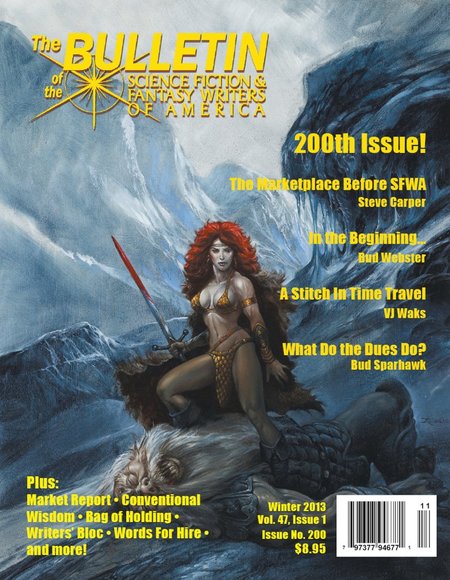
Where Jean Rabe Went Wrong, #2: At the 2012 Hugo Award ceremony, writer Jim C. Hines won the Best Fan Writer award, and this is how he accepted it:
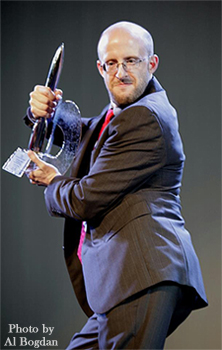
That spine-twisting pose is a nod to the series of blog posts he wrote beginning in January 2012 about the problem with many science fiction and fantasy book covers, which along with the help of Scalzi and four other SFWA members, he turned into a charity fundraiser to benefit the Aicardi Syndrome Foundation in honor of a friend’s child who died. (Ironically, in the comments to the blog post about the big group pose is a mention by commenter badducky about Bulletin #200.)
Rabe—who certainly would have been aware of Hines’ win in 2012 and what he wrote about which made him worthy of the nomination—should have thought twice about making the cover of the 200th issue an image of a woman in improbable armor. Or, if as Tobler sympathetically suggests the cover was meant to evoke a sense of nostalgia towards what fantasy covers used to look like, perhaps this should have been mentioned in that same “Letter from the Editor.” Again, any comment from Rabe would have been welcome and defused the tension surrounding the second half of the Resnick/Malzberg dialogues, but to my knowledge that didn’t happen.
Where Jean Rabe Went Right, #1: If there’s something that Rabe did correctly, it was to include an essay by Jim Hines called “Cover Art and the Radical Notion that Women Are People” in a subsequent issue, #202. But as you’ll read, by then it was “too little, too late.”
Problem #3: Issue #201 was the Spring 2013 issue, and it included an article by writer C.J. Henderson. According to writer Betsy Dornbusch, Henderson wrote about “staying power and reinventing oneself for career longevity.” And yet, he used an interesting example to illustrate his point:
The reason for Barbie’s unbelievable staying power, when every contemporary and wanna-be has fallen by the way-side is, she’s a nice girl. Let the Bratz girls dress like tramps and whores. Barbie never had any of that. Sure, there was a quick buck to be made going that route but it wasn’t for her. Barbie got her college degree, but she never acted as if it was something owed to her, or that Ken ever tried to deny her.
She has always been a role model for young girls, and has remained popular with millions of them throughout their entire lives, because she maintained her quiet dignity the way a woman should. [emphasis by Dornbusch]
Where Jean Rabe Went Wrong, #3: Dornbusch laid out very well exactly what’s wrong with Henderson’s premise and why it’s faulty to hold up Barbie as a positive role model of longevity, so I’m not going to repeat it. However, it’s an editor’s job to review every piece prior to publication to see if the writer is making claims that the organization can’t defend, especially the opinion pieces.
And if indeed a writer does make claims that aren’t easily defensible, it’s an editor’s job to note that while the publication stands by the writer’s right to his/her opinion, that it’s not the opinion of the organization as a whole. Again, such a statement—either behind the scenes in the private forums for SFWA members or a public notice on the website—would have gone a long way towards defusing the issue; as far as I researched, nothing to this effect was done by Rabe or the board of directors. If Locus editor-in-chief Liza Groen Trombi can admit to her editorial mistakes regarding an ill-written April Fools’ joke, why are Jean Rabe and the Bulletin above reproach regarding misogyny?
Problem #4: Recently published in Summer 2013, issue #202 contained a “rebuttal” by Resnick and Malzberg to the criticisms of their dialogue from issue #200; in the real world, Rabe probably would have been fired for letting the situation come to this point. As noted earlier, the issue contains a piece written by Hines which was probably prompted by the debate on the cover art from #200, but it was overbalanced by the somewhat incomprehensible back-and-forth between Resnick and Malzberg. Special thanks go to Natalie at Radish Reviews who had been able to obtain low-res images of the article so that both SFWA members and non-members could read and discuss the outrageous statements like this one from Barry Malzberg regarding the detractors:
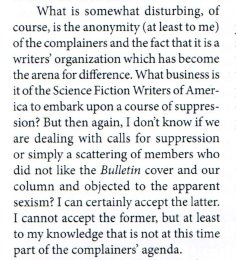
What makes this statement outrageous is Malzberg’s partial assumption that because there are some people who wished that the article had not been published in the Bulletin, then the injured parties may have wanted to suppress his and Resnick’s words. Of course, he retreats from committing himself to that false agenda (“to my knowledge that is not at the time part of the complainers’ agenda”), but by throwing in the word “suppression” he deliberately and mistakenly calls into mind an image of a specter of Senator Joe McCarthy or something Orwellian.
There’s also this statement by Mike Resnick, referring to the cover of issue #200, which I’ll return to later:
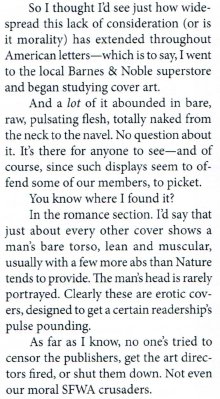
Both Natalie and Jason Sanford do an excellent job in explaining exactly why the latest Resnick/Malzberg dialogue is offensive, so I’m not going to go into it here. At this stage, however, I think that once writers start throwing around claims that they’re being “censored” in an opinion piece and calling their critics “liberal fascists,” it’s time to review with those writers what censorship actually means from a legal standpoint and how to properly respond to critiques written on the Internet.
I point to attorney and blogger Ken White at Popehat who in 2009 had to create a special tag for articles on the site about “thin skinned weenies” who were claiming that their First Amendment rights were being violated. White’s first paragraph explaining the new tag is as follows:
Let’s be clear—the right to free speech is the right to express oneself without state retaliation. It is not a right to speak without social retaliation. Speech has consequences. Among those consequences are condemnation, vituperation, scorn, ridicule, and pariah status. Those consequences represent other people exercising their free speech rights. That’s a feature of the marketplace of ideas, not a bug.
From the U.S. Bill of Rights:
Congress shall make no law respecting an establishment of religion, or prohibiting the free exercise thereof; or abridging the freedom of speech, or of the press; or the right of the people peaceably to assemble, and to petition the Government for a redress of grievances. [emphasis mine]
As no one from either of the gentlemen’s home states has introduced a bill into either the House or Senate asking that Mike Resnick and/or Barry Malzberg be prohibited for writing in the Bulletin about “lady writers” and “lady editors,” neither of them can credibly claim that they’re being censored. The fact that Rabe even gave them an opportunity to revisit the subject in issue #202 is proof that the editorial board of the Bulletin is encouraging their right to speak freely about their previous comments.
But instead of letting Resnick and Malzberg’s purple pens get away from them, Rabe should have done the following:
- Ensure that they understood exactly what it was that they wrote which some people found offensive.
- Explain the rationale of why it was offensive to them in a way that they would understand.
- Read their ensuing article to make damn well sure that they weren’t sticking their feet in their mouths again.
- Fact-check every claim made by Resnick and Malzberg to ensure that it wasn’t fallacious or damaging to the organization.
That way, Resnick could not have gotten away with his above statement regarding romance novel covers. And while it may probably have a grain of truth within it, that doesn’t mean that readers and fans aren’t as critical of romance novel covers and their sociological implications as Hines was in his essay and blog posts on science fiction and fantasy covers. In fact, a quick Google search brought up this article written in 1999, which can also incidentally be taken as proof that when it comes to decrying sexism in book covers, the romance readers were ahead of the curve. And let’s not forget this entire category of posts by the women behind Smart Bitches, Trashy Books. There’s even an entire doctoral dissertation on romance novel covers (link goes to a PDF), written by Dr. Jayashree Kamble in 2008.
If I could find those articles and/or have those references at my fingertips within the six hours it has taken me thus far to write this article, surely Rabe or one of her associate editors could have done the same amount of research—or more—and found better examples to show to Resnick and let him know that his rationale was faulty and how he could make his piece stronger.
Because that’s the other job of an editor: to point out where things don’t make any sense and most importantly, help make a writer’s work much stronger. And I think this is the most egregious error that Rabe committed: she left her writers out to hang themselves with their own words.
As of this writing, the SWFA announced on its website the creation of a task force “to look at the Bulletin and to determine how the publication needs to proceed from this point in order to be a valuable and useful part of the SFWA member experience.” At the same time, Scalzi made statements on Twitter which he collected in a post on his personal blog; as per his policy, he is not accepting comments on this matter on his personal blog, but by email at president@sfwa.org.
The task force also aims to “solicit further, detailed opinions from the membership as a whole about the Bulletin as part of an upcoming stage of the project.” I know that I’m not a SFWA member, but in sending a link to this article to vice president Rachel Swirsky and Scalzi as part of their work on this task force, I hope that what I’ve written can help them make the Bulletin a newsletter that the present and future membership can be proud of.
